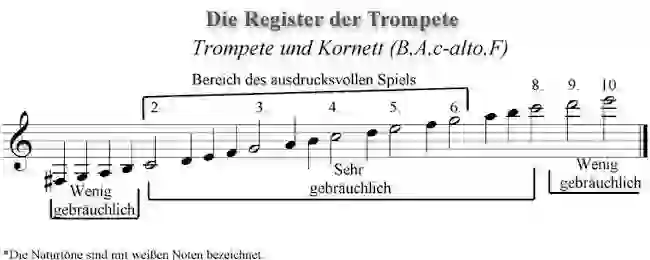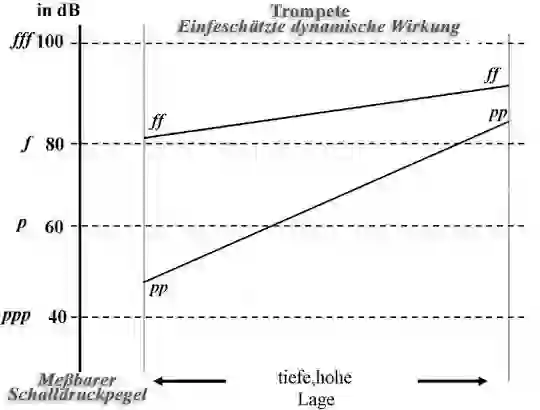Sound character of the Trumpet - Philipp Dangas
Trumpet register table
The sound character of the trumpet is shaped by the following factors:
- 1. Mouthpiece
- The mouthpiece of the trumpet is the most important factor in producing the timbre. Please note: the flatter the cup mouthpiece, the more brilliant and rich in overtones the sound.
- 2.Scale
- The ratio between the cross section and the length of the sounding tube. Please note: the tighter the scale, the more brilliant and rich in overtones the sound.
- 3. Tube
- Cylindrical tubes sound brighter and are richer in overtones. Instead, conical tubes sound softer and produce fewer overtones.
- 4. Bell
- Longer and narrower bells make the sound brighter. Shorter and wider bells soften the sound instead.
As part of the „symphonic world music“ The task of the trumpet can be to create contrast. In addition, the use of the trumpet in quiet dynamics is a beautiful example of the gentle creation of contrast.
Download size: 784 kilobytes
Table summary of the Sound character of the Trumpet
The registers and timbres of the trumpet are shown in the table below briefly described. The high register becomes the middle register and the low register and the deepest register described.
Dynamic effect of the trumpet
Sheet music for the dynamic table of the trumpetAt the dynamic table shows the different levels of musical dynamics. And in addition to the sound pressure scale measured in decibels, the degrees of strength of musical dynamics are given on the left, which can be understood as "objective" degrees.
Let's look at the diagram drawn to the right of the dB scale. It shows the estimated dynamic effect over the entire tonal range of the instrument. The dynamic effect (volume) as judged (perceived) by the listener.
In addition, the dynamic range of the trumpet in the low register, which is between pianissimo [pp] with 46 decibels [dB] and fortissimo [ff] with 82 decibels [dB] = 36 decibels [dB], is given as an example. In the high register, the range is 8 decibels [dB]. The estimated values can deviate more or less from the "objective" ones.
The deviations are fundamentally different from instrument to instrument. The "objective" degrees of intensity piano pianissimo [ppp]= 40 decibels [dB], p=60 decibels [dB] etc. enable the composer to predict the dynamic effects of different instruments that are sounding simultaneously.
Table summary of trumpet dynamic range
The following table shows the achievable dynamic range of the trumpet shown. The span is the difference between the fortissimo and the Pianissimo in the same pitch.

The register table of a trumpet in a large representation
- high register
- Penetrating and very brilliant
- middle register
- Brilliant but full-bodied metallic shine
- low register
- Strong and transparent
- lowest register
- Matte and quite dark

The dynamic table of a trumpet
Internal search function
| Name | Value | Delete |
|---|